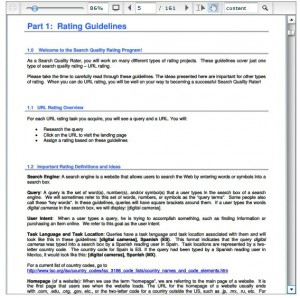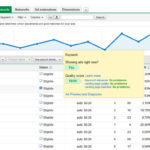Google’s uses human quality raters to grade search results. Last year, potpiegirl found a document from Google entitled “2011 Google Quality Raters Handbook”. We wrote a summary back then that we used to help our clients with their SEO. Recently a new version of the document was found. Shortly after this document was leaked, Google decided to release a version of the guidelines for public consumption. The new, public document is an edited version of the old one that circulated quietly several times amongst webmasters and SEOs. The new document is only 43 pages, vs the 161 pages that are available elsewhere.
The rating scale used is based on user search intent and the utility of the landing page based on that intent i.e. “Vital”, “Useful”, “Relevant”, “Slightly Relevant”, and “Off-Topic or Useless”. As a content creator, and web owner, we should all be aiming for the Vital and Useful end of the scale.
Search intent is broken into 3 clear areas;
- Action intent – Users want to accomplish a goal or engage in an activity, such as download software, play a game online, send flowers, find entertaining videos, etc.
- Information intent – Users want to find information. These are “know” queries: users want to know something.
- Navigation intent – Users want to navigate to a website or webpage. These are “go” queries: users want to go to a specific page.
When looking at the quality of a page, reviewers are asked to look at what the “Main Content” of the page is. The Main Content should be prominently displayed and “front and center”. It should be immediately visible when a user opens the page.
- It should be very clear what the Main Content actually is. The page layout, organization and use of space, as well as the choice of font, font size, background, etc., of the page should make this clear.
- The Main Content and Supplementary Content together should take up most of the space on the page.
- Ads and Supplementary Content should be arranged so as not to distract from the Main Content.
- It should be clear what parts of the page are Ads, either by explicit labeling or simply by page layout.
Low Quality Content
There are a few kinds of pages that will always be rated lowest on the overall page quality scale.
- Lack of purpose, if the page purpose cannot be identified, which includes reading the “about” and other similar pages on the website. Many “lack of purpose” pages are “gibberish” or auto-generated.
- Harmful purpose, if the purpose is clearly harmful or malicious. Obvious examples are phishing, malware, or harmful information.
- Deceptive pages, if a page is designed to look as though it has a helpful purpose but actually exists for some other reason. Deceptive pages are usually created to make money using ads or affiliate links rather than to help users.
Key points that show why a page might be rated as the lowest quality;
- Buying papers/scraping articles online or getting someone else to write for them.
- Making things up.
- Writing quickly with no drafts or editing.
- Filling the page with large distracting pictures.
- Copying the entire page from an encyclopedia, or paraphrasing content by changing words or sentence structure here and there.
- Filling up pages with completely obvious sentences that repeat the topic of the page. (“Argentina is a country. People live in Argentina. Argentina has borders. Some people like Argentina.”)
- Using a lot of words to communicate only basic ideas or facts (“Pandas eat bamboo. Pandas eat a lot of bamboo. It’s the best food for a Panda bear.”)
A rating of Off-Topic or Useless is given to pages that are helpful for very few or no users. Off-Topic or Useless pages are unrelated to the query and/or have no utility. For example, a page that has links and ads and no actual content. The links redirect to other pages that lead to yet other links and ads. When nothing on the page is helpful to the user, it will be rated Off-Topic or Useless. These pages usually warrant the Spam flag.
High or Highest Quality Main Content
The top 3 ratings for pages are Vital, Useful and Relevant. The Vital rating is only used for specific instances where the search intent exactly matches the page. So for instance someone searching for Stanford University or New York Times will get the web pages of these sites at the top. Most queries do not have Vital webpages for example;
- The query does not have a dominant interpretation.
- The query is not an entity or is not a navigation query.
- No official website or webpage exists for the entity.
- No person or entity can “own” the topic of the query.
A rating of Useful is assigned to pages that are very helpful for most users. Useful pages are high quality and a good “fit” for the query. In addition, they often have some or all of the following characteristics:
- highly satisfying,
- authoritative,
- entertaining,
- recent (such as breaking news on a topic).
Useful pages are usually well organized and pages you trust. They are from information sources that seem reliable. Useful information pages are not “spammy”.
A rating of Relevant is assigned to pages that are helpful for many or some users. Relevant pages have fewer valuable attributes than were listed for Useful pages. Relevant pages still “fit” the query, but might be less comprehensive, less up-to-date, come from a less authoritative source, or cover only one important aspect of the query.
Defining Highest Quality Main Content
Highest quality pages are highly satisfying to users. Highest quality pages have a large amount of very high quality content, very helpful supplementary content, and use very good webpage layout. The author(s) of the content on Highest quality pages should have a very high level of expertise in the subject.
In addition, Highest quality pages are often found on websites that have a very good reputation from experts in the topic (even if average users or raters are unaware of the site or its reputation). Reputation checks are an important part of identifying Highest quality pages.
- Highest quality pages have an obvious purpose and they achieve that purpose very well.
- The Main Content of Highest quality pages is created by people with a high level of expertise in the topic.
- Highest quality pages have a very satisfying amount of Main Content.
- The page layout on Highest quality pages makes the Main Content immediately visible (“front and center”).
- The space on Highest quality pages is used well.
- The Supplementary Content on Highest quality pages is helpful and contributes to a very satisfying user experience.
- Highest quality pages usually have near professional quality content, even though ordinary individuals may create the content.
- Highest quality pages frequently appear on high quality websites with very positive reputations for their purpose or topic, such as:
- Award winning newspaper sites for news
- Authoritative sites for medical information
- Well-known “go-to” recipe sites for recipes
- Highly regarded and trusted shopping sites
Supplementary Content
Supplementary Content is content that does not directly help the page achieve its purpose. Sometimes the easiest way to identify Supplementary Content is to look for the parts of the page which are not Main Content or Advertisements. High quality pages have helpful Supplementary Content, and that content contributes to a good user experience on the page. For example, one common type of Supplementary Content is navigation links which allow users to visit other parts of the website. On a video page, Supplementary Content might include related videos that users might be interested in watching. On a shopping page, Supplementary Content might include related products that users might be interested in buying.
Supplementary Content can be a large part of what makes a High or Highest quality page very satisfying for its purpose. Features designed to help shoppers find other products they might also like can sometimes be as helpful as the Main Content of a shopping page. Ways to find other cool stuff on entertainment websites can keep users happily browsing. Sometimes, the comments on a blog post are the most interesting part.
Using Lists
Some queries seem to “ask for a list”. When the query seems to ask for a list that includes many, many possibilities, individual examples usually are not as helpful as a list. When the list of possibilities is short, then individual examples are helpful. Sometimes, there are very famous or popular examples on the list. In these cases, the individual famous or popular examples are helpful, even if the list of possibilities is long. To summarize, if there are few items in the list, then high quality landing pages for individual items are helpful. If there are so many possibilities that any one item seems too specific, lists of results are usually more helpful, unless an individual item is very popular or highly expected.
New and Old Pages
Information or “know” queries may be about recent or past events. Some queries demand very recent results. For some queries, timeliness is very important. Queries for recent events and recurring events need pages with recent content. We assume that users who type queries looking for results from an election, sporting event, or other type of annual competition are looking for the most recent results, not results from previous years.
Queries with Local Intent
Some queries seem to “ask” for webpages about locations or businesses near the user. For example, the user intent for the query [coffee shops nearby], English (US) is to find coffee shops near the user’s location. There are also some queries that seem to “ask” for local information. For example, the user intent for [movie showtimes], English (US) is probably to find out what time movies are showing nearby. The user intent for the query [weather] is probably to find out about the current weather where the user is located. Users are interested in movies and weather in their location. We will consider these to be “local intent” queries as well.
Many or even most queries have no local intent. For example, [take an online personality test], English (US) is not a local intent query. Users are clearly looking for websites or webpages that will allow them to take a personality test. Users are not looking for a business or testing center near their physical vicinity (note the word “online” in the query). And personality tests are not different for users in different cities inside the US.
Duplicate Content
Copied or “scraped” content is created with deceptive intent and with very little time, effort, expertise, or talent. It is also a violation of the “Quality Guidelines” section of Google’s “Webmaster Guidelines”. Many low or lowest quality Main Content pages contain only copied or “scraped” content and were created with deceptive intent. Copied content may be copied exactly from an identifiable source. Sometimes a complete article is copied. Sometimes just parts of the article are copied. Text that has been copied exactly is usually the easiest type of copied content to identify.
Website Reputation as a Page Quality Signal
A website’s reputation is based on the experience of real users, as well as the opinion of people who are experts in the topic of the website.
- Stores have user ratings,
- newspaper website has won journalistic awards.
- medical information site is endorsed by physician groups.
- level of authoritativeness or expertise,
- expert opinions






